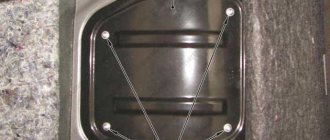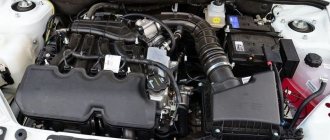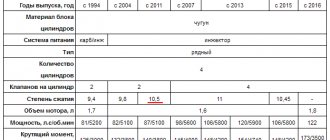November 26, 2014 Lada.Online 183 083 3
The Lada Granta is a budget front-wheel drive car that was developed on the basis of the Lada Kalina. Sales of the car began at the end of December 2011. Currently, 5 types of engines are installed on Lada Granta/Kalina 2:
- VAZ-11183-50 (82 hp)
- VAZ-11186 (87 hp)
- VAZ-21126 (98 hp)
- VAZ-21127 (106 hp)
- VAZ 21126-77 (120 hp)
Despite this diversity, the volume of all engines is the same and is 1.6 liters.
About modern VAZ engines
The manufacturer offers a choice of two 8 valve engines :
- VAZ-11183-50 (82 hp) is a modified VAZ-2111 engine, as a result of which environmental performance has increased, the engine has become more reliable and less capricious. It also has the advantage of elasticity and traction. Disadvantages include periodic valve adjustments and noisy engine operation. If the timing belt breaks, the valve does not bend.
- VAZ-11186 (87 hp) is a modified VAZ-21114 engine, as a result of which it was possible to reduce noise and gasoline consumption. Environmental friendliness has improved and power has increased noticeably. Disadvantages: compared to the VAZ-11183, this engine has a shorter service life. When the timing belt breaks, the valves bend.
16 valve engines :
- VAZ-21126 (98 hp) is a continuation of the VAZ-21124 engine and is currently one of the most advanced domestic engines. Disadvantage: valve bends when the timing belt breaks.
- VAZ-21127 (106 hp) is a modified VAZ-21126 engine. In comparison, the engine has become more torquey at the bottom, the changes are minor, but noticeable. The disadvantages include bending of the valves when the timing belt breaks.
Reliability, weaknesses, maintainability
Reliability
According to the majority of car owners, the VAZ-21127 engine is reliable and, what is especially pleasing, economical to operate. The reliability of the motor is confirmed by many factors.
Firstly, a resource. The manufacturer stated 200 thousand km. But practice shows that in reality it easily reaches 300-350 thousand km and this is not the limit.
The only thing you need to know is that such a mileage is only possible with proper care of the engine. This concept includes timely maintenance, the use of high-quality fuels and lubricants, reducing the time required for regular maintenance, and careful operation of the internal combustion engine.
Secondly, a high safety margin. Despite the fact that during assembly the VAZ-21127 already received factory tuning, the possibility of increasing power remained. But you need to be extremely careful in this matter - additional tuning of the engine significantly reduces its service life.
The pursuit of “extra horsepower” will result in a major overhaul of the entire engine in the near future.
Thirdly, engine reliability is ensured by the presence of imported parts and components (fuel rail, timing belt, tensioner, idler pulley, connecting rod and piston group, etc.).
Piston and connecting rod from Federal Mogul
Fourthly, the reliability of the internal combustion engine has been increased by improving some components and parts in comparison with its predecessor. Thus, the exhaust tract, the ignition system, the use of a metal impeller in the water pump, the replacement of the mass air flow sensor and a number of other innovations have been changed.
Thus, the sufficient reliability of the VAZ-21127 is not a myth, but a reality.
Weak spots
Despite the improvements made to the base model, the VAZ-21127 is not without weaknesses. Among them there are those that appear due to the fault of car owners.
Engine tripping. Most often, this problem occurs due to clogged fuel injectors or faulty spark plugs. In the first case, it is enough to flush the fuel system; in the second, you will have to change the spark plugs.
When the engine fails, the main share of the blame lies with the car owner, since untimely maintenance and refueling with low-quality gasoline are what cause this malfunction. Timely replacement of spark plugs (after 15-20 thousand kilometers of a car) also eliminates this problem in the internal combustion engine.
The next weak point is the possibility of engine overheating. The author of this phenomenon is a faulty thermostat. Its timely replacement prevents overheating of the motor. In this case, all elements of the cooling system must be clean and in working condition, the coolant level is normal, and there are no leaks in the system.
Electrical malfunctions. Here, first of all, doubts about the performance are caused by the ECU, ignition coils and sensors. The true cause of failures can only be identified by diagnosing the engine at a specialized service station.
Timing belt Engines manufactured before July 2022 are of particular concern. Their problem was that the valves were bent when the timing belt broke. The manufacturer stated its resource is 180-200 thousand km, but you should not delude yourself with this.
The fact is that the belt can wear out, but the deflection pulley does not. At about 80 thousand km, the car jams. As a result, the drive belt breaks.
The condition of the timing belt must be monitored
Engines manufactured after this date do not have the problem of bent valves. This is facilitated by specially designed pistons.
Car owners often notice extraneous knocking noises in the engine. As a rule, this noise is created by hydraulic compensators. But knocking can also be caused by an extremely worn SHPG, or, less commonly, by burnt-out valves. In any case, when knocking occurs, the engine requires professional diagnostics.
Malfunctions detected and corrected in a timely manner postpone repairs for a long time.
Technical characteristics of VAZ engines
| VAZ-11183 | VAZ-11186 | VAZ-21126 | VAZ-21127 | |
| Installed on the car | Lada Kalina, Lada Granta | Lada Kalina, Lada Granta | Lada Kalina, Lada Granta, Lada Priora | Lada Kalina, Lada Granta, Lada Priora |
| Years of production, year | since 2004 | since 2011 | since 2007 | since 2013 |
| Cylinder block material | cast iron | cast iron | cast iron | cast iron |
| Supply system | injector | injector | injector | injector |
| Type | in-line | in-line | in-line | in-line |
| Number of cylinders | 4 | 4 | 4 | 4 |
| Valves per cylinder | 2 | 2 | 4 | 4 |
| Compression ratio | 9,6 | 10,5 | 11 | — |
| Engine volume, l | 1,6 | 1,6 | 1,6 | 1,6 |
| Power | 82hp/5200rpm | 87hp/5100rpm | 98hp/5600rpm | 106hp/5800rpm |
| Torque | 125Nm/3000rpm | 140Nm/3800rpm | 145Nm/4000rpm | 148Nm/4000rpm |
| Fuel consumption (city/highway/mix), l | 8.8/6.2/7.6 per 100km | 8.5/5.7/7.2 per 100km | 9.8/5.4/7.2 per 100km | -/-/7 per 100km |
| Oil consumption | 50g/1000km | 50g/1000km | 50g/1000km | 50g/1000km |
| Engine life (according to the passport/actually) | 150/250-300 thousand km. | 200/- thousand km. | 200/200 thousand km. | 200/200 thousand km. |
See also the characteristics of Lada Granta and Lada Kalina 2.
Lada Granta engines 16 valves
This engine is also equipped with a lightweight piston group manufactured by Federal Mogul and a belt with an automatic tensioner from Gates. It is distinguished by a 16-valve head with a pair of camshafts and hydraulic compensators, due to which its power is significantly higher.
All the problems of its predecessors apply to this unit in full. The engine often suffers from lubricant leaks, tripping, floating speed, sensor glitches and valve burnout. Plus, you can add hydraulic compensators that are very demanding on oil quality.
All technical characteristics of the engine are described on the Motor VAZ portal
The updated engine received an adjustable intake tract with dampers in the receiver channels. Also here, the mass air flow sensor gave way to a combination of absolute pressure and air temperature sensors, thanks to which the frequent problem of floating speed at idle has finally gone away.
The reliability of the new unit has increased, although it is not flawless. The thermostat also often fails, the injectors become clogged, and the ignition system malfunctions. But the main threat is the water pump, because of the wedge of which the timing belt breaks and the pistons meet the valves. Update: In July 2022, the manufacturer equipped this engine with plugless pistons.
All differences from its predecessors are described in one of the blogs on Drive 2
Source
Technical characteristics of the VAZ-21126-77 engine
| VAZ-21126-77 | |
| Installed on cars: | Lada Granta Sport and Lada Kalina Sport |
| Years of production, year | since 2013 |
| Cylinder block material | cast iron |
| Supply system | injector |
| Type | in-line |
| Number of cylinders | 4 |
| Valves per cylinder | 4 |
| Compression ratio | 11 |
| Engine volume, l | 1,6 |
| Power | 120hp/5900rpm |
| Torque | 154Nm/4740rpm |
| Fuel consumption (city/highway/mix), l | -/-/7.8 per 100 km |
| Oil consumption | 50g/1000km |
| Engine oil quantity | 3.5l |
| Engine life (according to the passport/actually) | 200/200 thousand km. |
Let us remind you that in another article we determine the best VAZ engine for a modern Lada car.
Keywords: Lada Granta engine | Lada Kalina engine
0 0 0 0 1 0
Share on social networks:
Lada Granta engines 8 valves
This power unit was installed only until December 2014, until it gave way to the 11186 internal combustion engine. This is an injection 8-valve engine with a single camshaft, a timing belt drive and without hydraulic compensators, so the thermal valve clearances here will have to be adjusted yourself. Thanks to special holes in the pistons, if the valve belt breaks, it will never bend.
There are plenty of problems with this engine; first of all, owners are bothered by all sorts of noises, knocks, and vibrations. Unreliable electrics, as well as a capricious thermostat, can throw you many unpleasant surprises. Due to poor fuel, valve burnout sometimes occurs here.
Similarly, the Motor VAZ website talks about all the details of the internal combustion engine design
This unit is an improved version of the previous one. There is already a lightweight piston with anti-friction inserts, a timing belt from Gates with a service life of 180 thousand km, an electronic throttle valve, a developed cooling jacket and many other improvements, thanks to which it was possible to fit this rather old engine into the strict EURO 4 econorms. Due to the new pistons without holes in the bottom, if the valve belt breaks, it almost always bends. Update: in mid-2022, the manufacturer equipped the unit with plugless pistons.
Malfunctions: causes, elimination
Like all internal combustion engines with mechanical adjustment of valve clearances, the 11186 engine requires periodic adjustment of this characteristic. In addition, during operation, characteristic “diseases” of this particular version of the power drive were identified:
| Bend valves | broken timing belt | periodic wear monitoring |
| Ignition system interruptions | failure of the corresponding block | replacing the ignition module |
| Increased oil consumption | wear of the main bearings, stuck piston rings | replacement of consumables |
| Knock | wear of pistons, bearings | replacement of parts |
When repairing piston and crankshaft engines, it is recommended to use original components from the AvtoVAZ manufacturer. Because only he uses special technologies for strengthening structural materials. From third-party companies, the metal may be “raw”; the resource of such consumables cannot be analyzed.
The ignition module cannot be repaired











